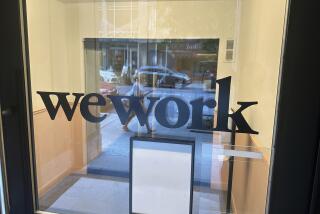A Long, Sad Chapter 11 in History: Bankruptcies in 2002 Set Record
2002 may well go down as the year of the fallen giants.
A weak economy and widespread accounting irregularities conspired to fuel what by one measure has been the biggest year ever for corporate bankruptcies, with the value of 2002 filings soaring to a record $368 billion as of Dec. 25, BankruptcyData.Com reported Monday.
The number of public companies filing for Chapter 11 Bankruptcy Court protection was actually higher in 2001: 257 versus 186 so far this year. But when measured by assets, the 2002 filings -- bloated by big names such as WorldCom Inc., Global Crossing Ltd., Kmart Corp., Conseco Inc., Adelphia Communications Inc. and UAL Corp. -- shattered last year’s record by 42%. In fact, five of the 10 biggest bankruptcies of all time occurred this year.
The trail of wreckage has left business experts nervously discussing the consequences of such massive failures on the U.S. economy and investor confidence.
“Bankruptcies have a ripple effect, touching suppliers, customers, banks and other relationships,” said Samuel Gerdano, executive director of the American Bankruptcy Institute. The Alexandria, Va., group is made up of attorneys, auctioneers, bankers, judges and others involved in the Chapter 11 process.
In many ways, 2002 merely marked an extension of a trend that started in 2001. Over the last two years, companies with $626 billion in assets have filed for Chapter 11, according to Christopher Stuttard, editor at BankruptcyData.Com, a Boston-based Web site that tracks corporate filings.
That dwarfs the cumulative asset total of all the corporate bankruptcy filings logged during the previous decade, although it’s worth noting that assets listed in court filings often bring pennies on the dollar when they are sold during reorganization proceedings.
Meanwhile, the prognosis for next year is equally bleak.
“We polled our members earlier this month, and a healthy majority felt that 2003 would bring bankruptcies to another new record,” Gerdano said.
The surge in corporate bankruptcies is largely blamed on the 1990s “bubble” mentality that inspired banks and investors to pour money into companies that didn’t always have the soundest business plans. That, in turn, encouraged some corporate managers to overextend themselves as they grew and acquired new businesses.
Accounting scandals at companies such as WorldCom and Adelphia also figured in the debacle.
“We are in the classic post-bubble period,” said James A. Pressler, associate economist at Northern Trust Co. “It’s only exacerbated by the fact that the WorldComs and Enrons -- the big, supposedly successful companies -- were humbled overnight.”
Going forward, economists fear that U.S. debt levels remain troublingly high, with consumer indebtedness and personal bankruptcy filings at or near postwar records. Consumer debt is considered an important factor, even in corporate bankruptcies, because consumer spending accounts for two-thirds of economic growth.
If consumers aren’t financially healthy enough to head to the mall, corporate profits are likely to languish. That has a negative effect on everything from employment to the stock market. Indeed, some experts already are singling out the retail sector as a potential hot spot for bankruptcy filings next year.
“Most people don’t understand how each dollar spent in one industry trickles down into other industries, affecting everything from plant services to advertising,” said Jack Kyser, chief economist at the Los Angeles County Economic Development Corp.
“I think this recession has really put pressure on a lot of companies -- particularly small and mid-sized companies -- that they were just not prepared for.”
Michael Brown, spokesman for Consolidated Freightways Corp., which was once California’s biggest trucking company, can attest to that. Although the company began to falter two years ago, it had positioned itself to prosper from the predicted economic recovery. But the upturn proved too little, too late. Consolidated filed for bankruptcy protection in September.
“We felt we were doing a lot of the right things to take advantage of it when the economy began to take off,” Brown said, “but by September it became apparent to us that we were not going to be able to recover.”
The only bright spot on the horizon: Bankruptcies often soar at the tail end of an economic downturn, noted Gary Schlossberg, senior economist at Wells Capital Management in San Francisco. That could mean that the worst is over, even if there are still some bad times to come.
“Bankruptcies are more the caboose than the engine,” Schlossberg said. “The problem is that this train has a long tail.”
*
(BEGIN TEXT OF INFOBOX)
California bankruptcies
The largest public companies in California to file for Bankruptcy Court protection in 2002, based on the value of assets.
*
Global CrossingJan. 28Beverly Hills**$22,400.0
Filing date:
City:
Assets (millions):
*
Peregrine SystemsSept. 22San Diego1,700.0
Filing date:
City:
Assets (millions):
*
Consolidated Freightways Sept. 3Mira Loma***783.6
Filing date:
City:
Assets (millions):
*
Clarent Dec. 16Redwood City507.6
Filing date:
City:
Assets (millions):
*
Globalstar Feb. 15San Jose500.0
Filing date:
City:
Assets (millions):
*
PrandiumMay 6Irvine173.9
Filing date:
City:
Assets (millions):
*
ZiLogFeb. 28San Jose170.8
Filing date:
City:
Assets (millions):
*
Integrated Telecom ExpressOct. 8San Jose116.0
Filing date:
City:
Assets (millions):
*
Diva Systems May 29Redwood City82.8
Filing date:
City:
Assets (millions):
*
Beyond.com Jan. 24Santa Clara43.5
Filing date:
City:
Assets (millions):
*
** Executive offices were in Beverly Hills; legal headquarters are in Bermuda.
*** Has since moved headquarters to Vancouver, Wash.
*
Source: BankruptcyData.com, Times research
More to Read
Inside the business of entertainment
The Wide Shot brings you news, analysis and insights on everything from streaming wars to production — and what it all means for the future.
You may occasionally receive promotional content from the Los Angeles Times.










